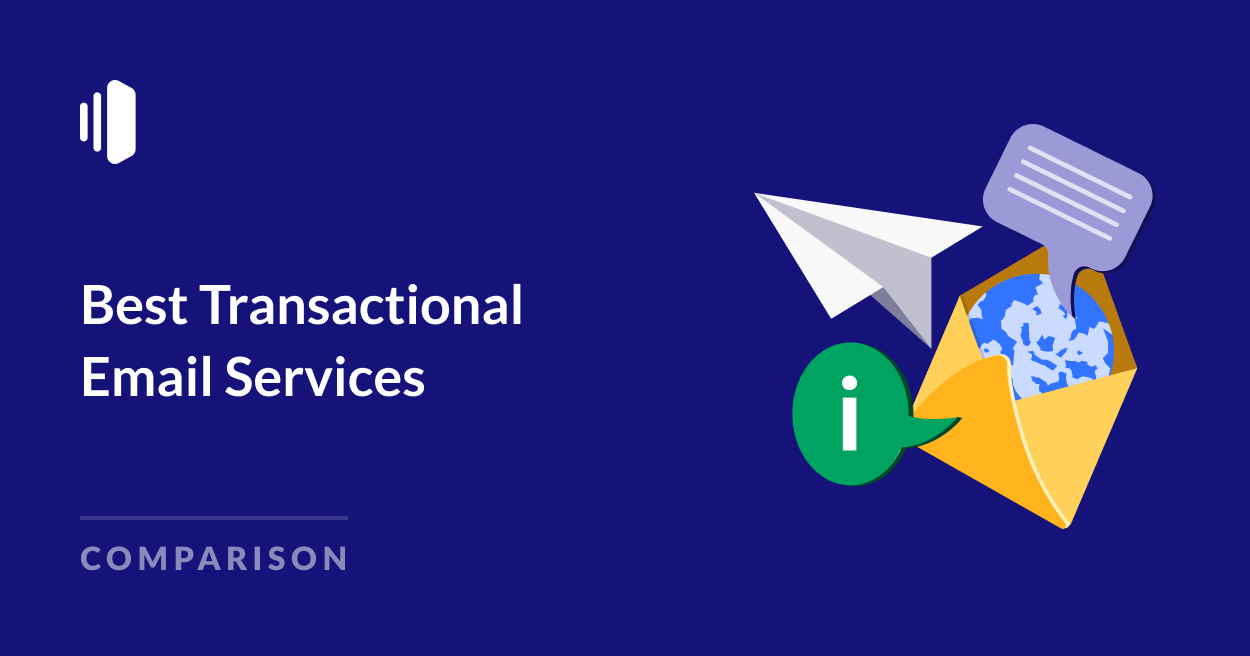Welcome emails, password resets, order confirmations: your users need them, and you need to deliver them reliably. That’s where transactional email service providers come in.
But how do you choose the right one for your business?
In this guide, I’ll break down the top transactional email providers, comparing features, pricing, and real-world performance. Whether you’re a small startup or a growing e-commerce site, you’ll find a service to meet your needs in this list.
Best Transactional Email Providers Compared
Don’t have time to read the whole article? Here’s a quick overview to help you choose the right transactional email service for your needs.
| Service | Best For | Free Tier | Starting Price |
|---|---|---|---|
| SendLayer | Small to medium businesses, startups | 200 emails | $5/month |
| SMTP.com | Medium to large businesses with high volume | 30-day trial (50k emails) | $25/month |
| Brevo | Small to medium businesses wanting all-in-one solution | 300 emails/day | $9/month |
| Mailgun | Developers and technical teams | 100 emails/day | $15/month |
| SendGrid | Businesses sending high volumes | 100 emails/day (60-day trial only) | $19.95/month |
| Amazon SES | AWS users, high-volume senders | 62k emails/month (from EC2) | Pay as you go, $0.10 per 1,000 emails |
| Postmark | Businesses prioritizing speed | 100 emails/month | $15/month |
Note: Pricing and features are subject to change. Always check the provider’s website for the most up-to-date information.
How to Choose the Right SMTP Provider for Your Needs
Selecting the right transactional email provider is crucial for your business. Here are some factors to consider:
1. Volume: How many emails do you need to send per month? Some providers are better suited for low volumes, while others excel at high-volume sending.
2. Scalability: Will your email needs grow significantly in the near future? Choose a provider that can scale with your business.
3. Ease of Use: If you’re not technically inclined, look for providers with user-friendly interfaces and easy setup processes.
4. Deliverability: Check the provider’s reputation for deliverability. High deliverability rates ensure your emails reach your customers’ inboxes.
5. Features: Do you need advanced features like A/B testing, email templates, or detailed analytics? Make sure your chosen provider offers the features you need.
6. Integration: Ensure the provider integrates well with your existing systems, especially your website platform (e.g., WordPress).
7. Support: Consider the level of customer support offered, especially if you’re new to managing transactional emails.
8. Pricing: Compare pricing structures and find a provider that offers good value for your specific needs.
9. Compliance: Ensure the provider helps you stay compliant with email regulations like GDPR, CAN-SPAM, and Gmail and Yahoo’s sender requirements.
10. Reputation: Look for providers with a strong track record and positive reviews from other users.
Best Transactional Email Services
I personally tested each of these email services’ free plan (where available) to get an accurate picture of the ease of setup and included features. Other details about customer support, reliability, and deliverability are collated from customer reviews from various sources.
1. SendLayer
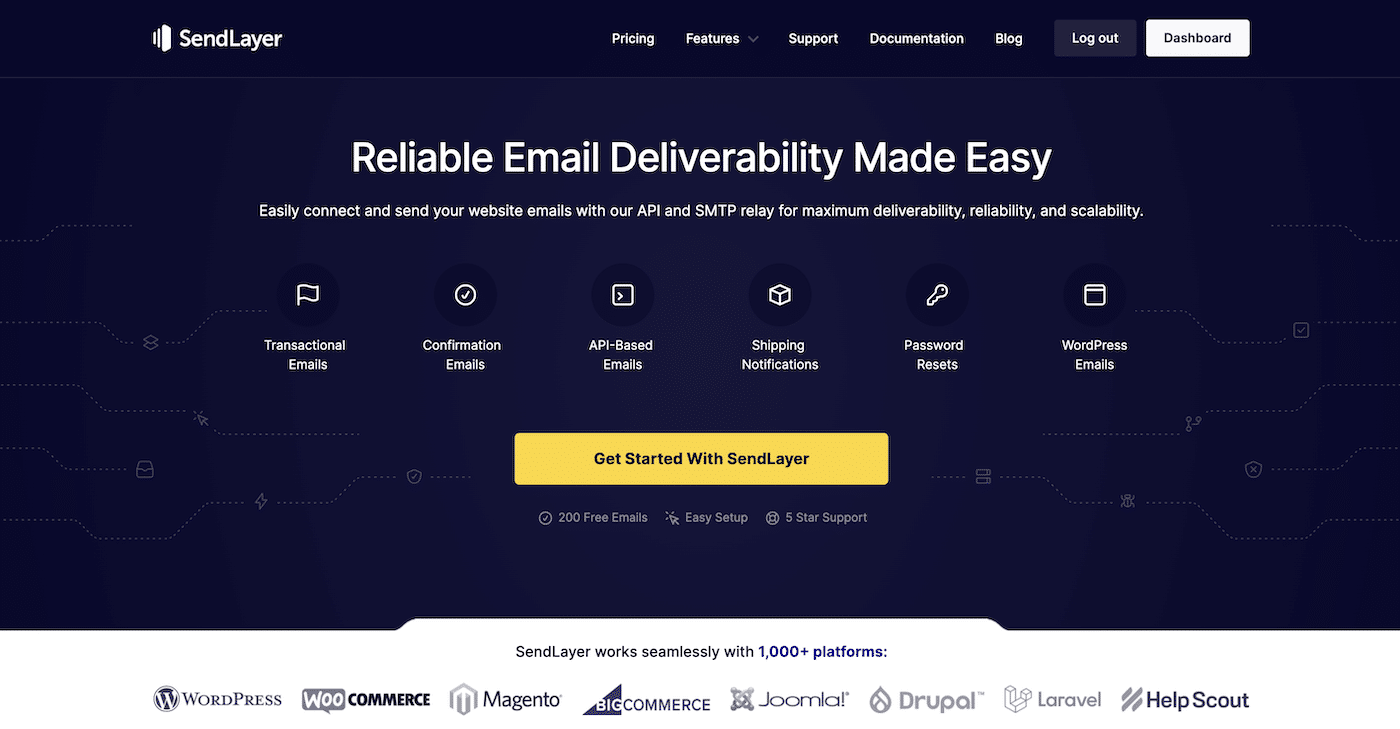
SendLayer is a dedicated transactional email service, designed with small businesses, developers, and growing websites in mind. SendLayer was built to be intuitive, scalable, and reliable, addressing the common pain points that many businesses face when dealing with transactional emails.
With SendLayer, you can easily set up and manage your transactional emails, track their performance, and ensure high deliverability rates.
One of the key features of the platform is an analytics dashboard where you can view detailed information about your emails, including delivery rates, open rates, click-through rates, unsubscribes, and spam complaints.. This data is crucial for optimizing your transactional emails and improving their effectiveness over time.
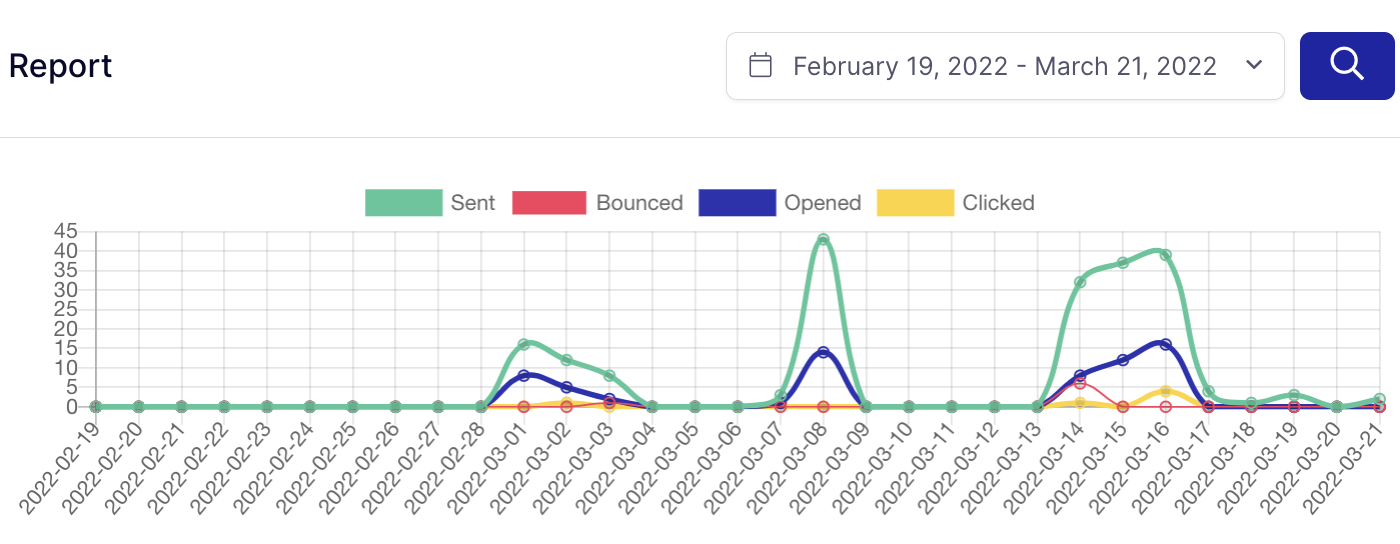
SendLayer also prioritizes the protection of your domain’s sender reputation. The system uses customizable suppression lists to prevent emails from being sent to addresses that have previously bounced or complained. Additionally, there’s a robust spam-protection system and email are sent from a subdomain, which adds an extra layer of protection for your main domain’s reputation.
Who This Service is Most Suitable For
SendLayer is ideal for small to medium-sized businesses, startups, and growing e-commerce sites. If you’re looking for a service that can grow with your business and provides excellent value for money, SendLayer is a great choice.
My Experience
I’ve been using SendLayer on the Starter plan for over a year and so have had the opportunity to test the service extensively.
I use SendLayer to send emails from my WordPress site (which is incredibly simple with the Easy WP SMTP plugin). In addition, I’ve tested both the SMTP relay and the API on dozens of other platforms including WooCommerce, Magento, Joomla, Supabase, Chargebee, Moodle, phpBB, OpenCart, Laravel, JavaScript, Python, and others.
I can confirm that SendLayer lives up to its promise of being easy to use, and it took me just a few minutes to set up my account as a new user and start sending emails. There’s even documentation that goes through the steps of setting up SPF, DMARC, and DKIM authentication in popular domain providers.
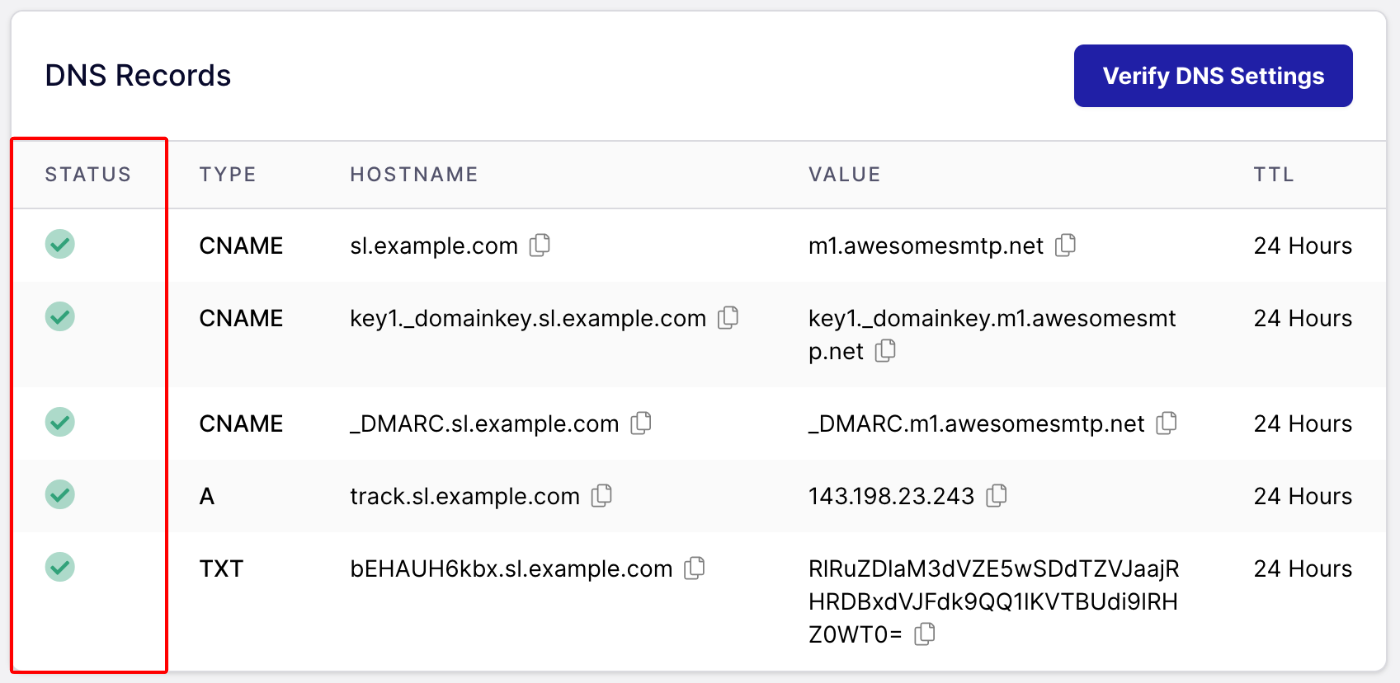
The analytics have been particularly useful for me. I can easily track when emails are being opened and clicked, and spot any issues if an email fails to send. I also appreciate the peace of mind that comes with knowing my domain’s reputation is being protected.
Pros and Cons
👍 Pros:
- User-friendly interface
- Scalable plans to grow with your business
- Excellent deliverability rates
- Robust analytics and reporting
- Affordable pricing, especially for small businesses
👎 Cons:
- Currently SendLayer only supports transactional email to ensure the highest deliverability, so if you’re looking for a provider that will also handle your marketing email, you’ll need to consider an additional service.
Pricing
- 1,000 emails – $5/month
- 5,000 emails – $15/month
- 10,000 emails – $25/month
SendLayer’s pricing is designed to be affordable and scalable. You can try out the service with a free plan that allows you to send up to 200 emails.
Paid plans start at just $5 per month for up to 1,000 emails, making us one of the most cost-effective options for small businesses. As your needs grow, you can easily upgrade to higher volume plans. There are also custom enterprise plans available for businesses with very high email volumes.
2. SMTP.com
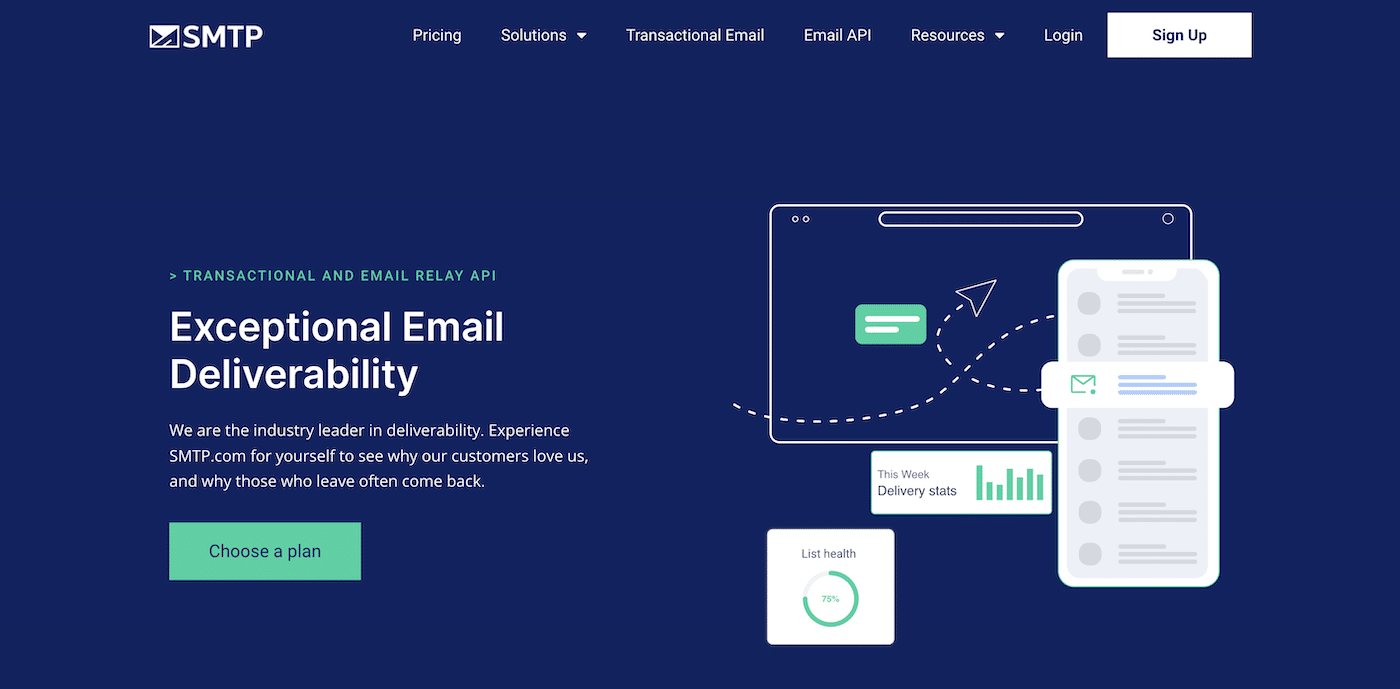
SMTP.com is a veteran in the email delivery space, known for its robust infrastructure and high-volume capabilities. The service is designed to handle large-scale email operations efficiently, making it a popular choice for established businesses with significant email needs.
One of SMTP.com’s standout features is its promise of near-instantaneous email delivery. They claim that most transactional emails are delivered “in a matter of seconds,” which can be crucial for time-sensitive communications like password resets or order confirmations.
Another notable aspect of SMTP.com is its reputation defender feature, which monitors your email list health, provides detailed delivery reports, and automatically suppresses invalid email addresses.
Who This Service is Most Suitable For
SMTP.com is best suited for medium to large businesses with high email volumes. It’s particularly appropriate for companies that prioritize delivery speed and need robust tracking capabilities and a flexible API. If you’re sending at least 50,000 emails per month and require enterprise-grade features, SMTP.com could be a good fit.
My Experience
When I first tried SMTP.com, I was immediately impressed by the depth of features available. The setup process was simple, and there’s a handy onboarding process to walk you through authentication.
The delivery speed lived up to the hype – I sent a test batch of emails and they arrived in my test inboxes almost instantly. The tracking features were also impressive. I could see detailed information about each email’s journey, which was helpful for identifying and resolving delivery issues.
However, I did find the pricing to be on the higher side, especially considering my relatively low email volume. For a small business or a personal project, it felt like more than I needed. Overall, while SMTP.com is clearly a powerful and capable service, I felt it was geared more towards larger operations than my current needs.
Pros and Cons
👍 Pros:
- Fast email delivery
- Comprehensive tracking and analytics
- 24/7 customer support
- High deliverability rates
- Scalable for very high volumes
👎 Cons:
- Higher pricing, especially for lower volume senders
- Might be overkill for small businesses or those just starting out
Pricing
- 50,000 emails – $25/month
- 100,000 emails – $80/month
- 500,000 emails – $300/month
- 1,000,000 emails – $500/month
SMTP.com’s pricing starts at a higher rate compared to some other providers, especially for lower volume senders. However, they offer a 30-day free trial with up to 50,000 free emails, allowing you to thoroughly test their service before committing.
3. Brevo

Brevo, formerly known as Sendinblue, has made a name for itself as a versatile all-in-one marketing platform that includes robust transactional email capabilities. This service stands out for its user-friendly interface and comprehensive feature set that goes beyond just email delivery.
One of Brevo’s key strengths is its integration of transactional and marketing email services. This can be particularly beneficial for businesses looking to streamline their email operations under a single platform. The service offers a drag-and-drop email builder, making it easy to create visually appealing transactional emails without needing design skills.
Brevo also provides advanced features like email automation, which allows you to set up complex transactional email workflows. For instance, you could create a series of automated emails for a user onboarding process or a multi-step order confirmation sequence.
Who This Service is Most Suitable For
Brevo is well-suited for small to medium-sized businesses that want an all-in-one email solution. It’s particularly appealing for companies that want to manage both their transactional and marketing emails from a single platform.
My Experience
Because Brevo is such a huge and wide-ranging platform, it can be a little overwhelming at first. I didn’t need the features such as SMS and WhatsApp marketing but they may be useful for businesses running multi-channel marketing campaigns.
Brevo comes with a drag-and-drop email builder and customizable templates which are particularly useful for marketing emails, but they can also be used to level-up your transactional emails.
The automation features were a pleasant surprise. I set up a simple onboarding email sequence, and it worked flawlessly, sending out emails at preset intervals after user sign-up.
The free plan was generous enough for me to thoroughly test the service before committing to a paid plan. Overall, I found Brevo to be a solid choice, especially for businesses looking for an all-in-one email solution.
Pros and Cons
👍 Pros:
- User-friendly interface with drag-and-drop email builder
- Integrated transactional and marketing email services
- Robust automation capabilities
- Generous free plan
- Wide range of integrations
👎 Cons:
- May not be as specialized for high-volume transactional email as some dedicated providers
- Some users report occasional deliverability issues
- Advanced features may require a learning curve
Pricing
- 5,000 emails – from $9/month
- 10,000 emails – from $17/month
- 20,000 emails – from $29/month
- 40,000 emails – from $39/month
- 60,000 emails – from $55/month
- 100,000 email – from $69/month
Brevo’s pricing for lower email volumes is quite competitive, especially considering the breadth of features offered. The free plan includes up to 300 emails per day, while paid plans start at $9 per month for up to 5,000 emails (although you’ll need to pay an additional $12 a month to remove Brevo branding.) This makes it an affordable option for small to medium-sized businesses.
4. Mailgun
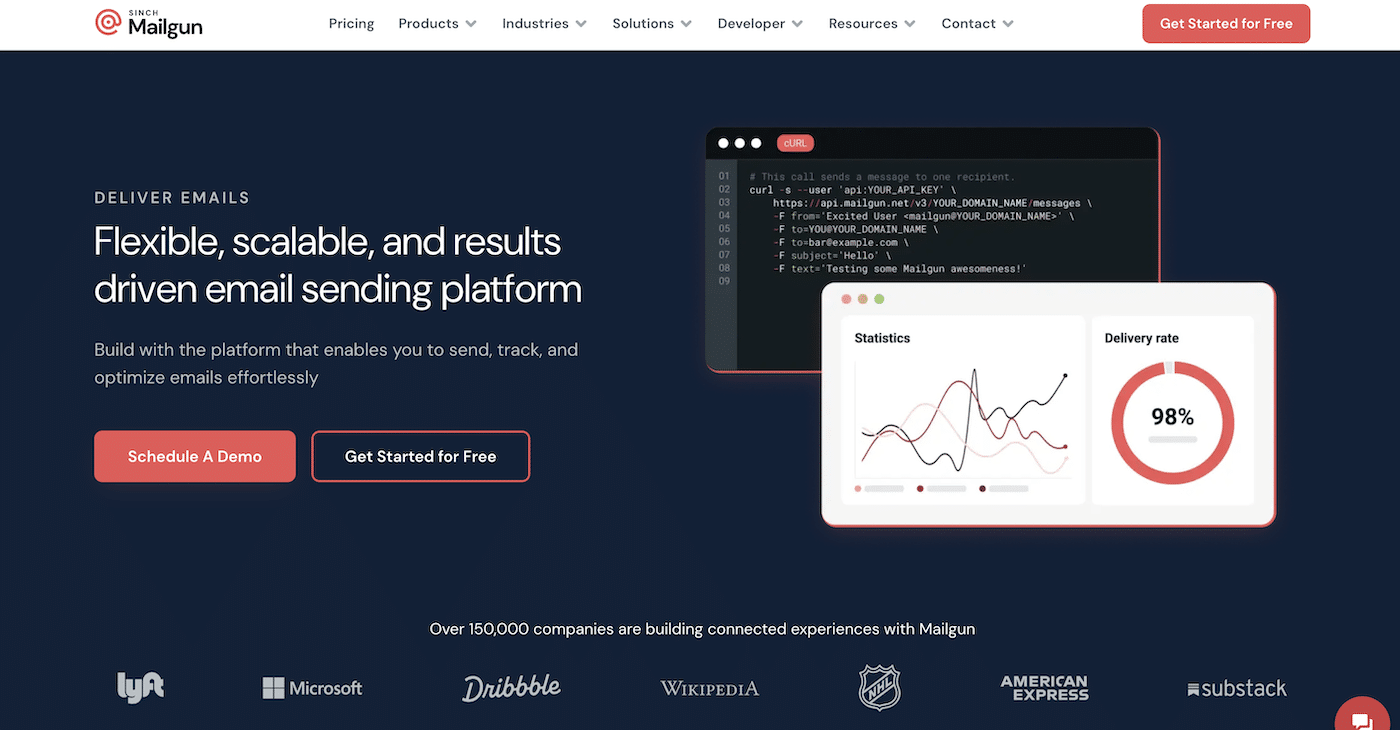
Mailgun is a transactional email service that’s known for its developer-friendly approach and powerful API. It’s designed to handle high volumes of email with reliability and speed, making it a popular choice among tech-savvy teams and companies with complex email needs.
The flexible and well-documented API allows developers to integrate Mailgun’s services deeply into their applications, enabling advanced email functionality and automation. The service supports a wide range of programming languages, making it versatile for different tech stacks.
Mailgun also offers advanced email validation services. This feature helps clean your email lists, reducing bounces and improving overall deliverability. Their email parsing functionality is another unique offering, allowing you to receive and process incoming emails programmatically.
Who This Service is Most Suitable For
Mailgun is best suited for developers and companies with technical teams who can take full advantage of its API and advanced features. It’s particularly good for businesses that need to send high volumes of emails or require complex email automation and processing.
My Experience
Although Mailgun is aimed at developers, I found it quick and easy to set up for the first time. The dashboard provides an at-a-glance view of deliverability and email opens and there’s also a reporting dashboard where you can run detailed reports.
Most of Mailgun’s optimization features are unavailable on the free account but if you’re considering the service as your main transactional email provider, it’s definitely worth the upgrade to use them.
The mail placement tool shows you which folders your emails are likely to end up in, and gives you tips to help more of them land in the inbox. You can also import Google Postmaster data and monitor blacklists directly from your Mailgun dashboard.
Pros and Cons
👍 Pros:
- Powerful and flexible API
- Advanced email validation and parsing features
- Detailed analytics and logs
- Scalable for very high volumes
- Competitive pricing for high-volume senders
👎 Cons:
- Can be complex for non-technical users
- Basic plan lacks some features available in other providers
- Email support only on lower-tier plans
Pricing
- 10,000 emails – $15/month
- 50,000 emails – $35/month
- 100,000 emails – $90/month
Mailgun’s free plan includes up to 100 emails a day with basic features. You can also scale up from the basic plans by paying per 1,000 emails. For those who want to focus on optimization, different plans are available with email previews, placement tests, and address validations.
5. SendGrid

SendGrid is one of the most well-known names in the transactional email space, and for good reason. The service offers a robust platform that can handle both transactional and marketing emails at scale, making it a versatile choice for businesses of all sizes.
One of SendGrid’s key strengths is its excellent deliverability rates. They use a combination of dedicated IP addresses, authentication protocols, and machine learning to ensure that your emails reach their intended recipients’ inboxes.
SendGrid offers both SMTP relay and a Web API for sending emails, providing flexibility in how you integrate the service with your applications. Their API is well-documented and supports multiple programming languages, making it developer-friendly.
For those who prefer a more visual approach, SendGrid also provides a drag-and-drop email builder and a variety of templates. This can be particularly useful for creating visually appealing transactional emails without needing design skills.
Who This Service is Most Suitable For
SendGrid is most suitable for businesses sending higher volumes of emails. It’s particularly good for companies that need to send both transactional and marketing emails and want to manage everything from a single platform. The service is also well-suited for developers who want to leverage its powerful API.
My Experience
When I first started using SendGrid, I was impressed by the breadth of features available. Setting up my first transactional email campaign was straightforward, thanks to the intuitive email builder and pre-designed templates.
I particularly appreciated the detailed analytics provided. Being able to see real-time data on opens, clicks, and bounces helped me refine my email strategy over time.
One minor frustration was navigating the user interface. At times, it felt like certain features were buried in unintuitive places, although I got more comfortable with it over time.
Overall, I found SendGrid to be a robust and reliable service for my transactional email needs. The ability to handle both transactional and marketing emails from the same platform was a significant advantage.
Pros and Cons
👍 Pros:
- Excellent deliverability rates
- Supports both transactional and marketing emails
- Powerful API and SMTP relay options
- Detailed analytics and reporting
- Scalable for very high volumes
👎 Cons:
- Can be more expensive than some competitors for lower volume senders and there’s no free tier – ony a free trial
- Some users report that the user interface can be confusing
- Advanced features may require a learning curve
Pricing
- 100,000 emails – from $19.95/month
- 2.5 million emails – from $89.95/month
SendGrid’s transactional email plans with SMTP relay and API are designed for high-volume senders and start from $19.95 a month. However, you can also take advantage of the free trial, which allows you to send up to 100 emails per day for 60 days.
6. Amazon SES
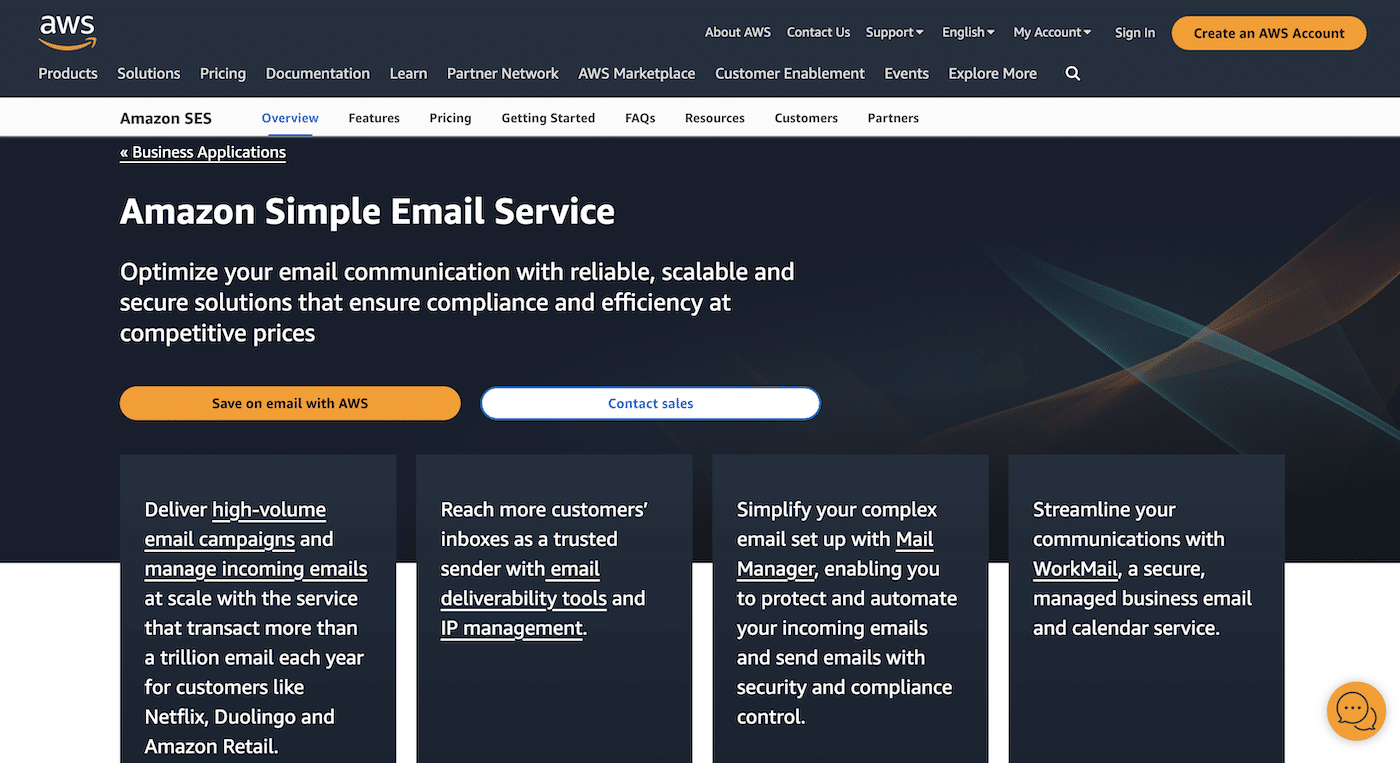
Amazon Simple Email Service (SES) is a cloud-based email sending service that’s part of the Amazon Web Services (AWS) suite. It’s known for its high scalability and cost-effectiveness, particularly for businesses already using other AWS services.
Amazon’s pricing model makes it one of the most affordable options for high-volume senders, making it attractive for businesses that need to send large quantities of emails.
The platform provides both an SMTP interface and a powerful API, giving developers flexibility in how they integrate the service. It supports sending emails, receiving emails (which can then trigger other AWS services), and email tracking.
While SES doesn’t offer as many bells and whistles as some other providers, it excels in its core function: reliably delivering high volumes of email. It leverages Amazon’s robust infrastructure to ensure excellent uptime and delivery speeds.
Who This Service is Most Suitable For
Amazon SES is best suited for businesses already using AWS services, developers comfortable with a more hands-on approach, and companies that need to send high volumes of email at a low cost. It’s particularly good for those who prioritize scalability and are willing to trade some ease-of-use for cost savings.
My Experience
The Amazon SES platform immediately felt more technical and less user friendly than most of the other SMTP services I tried.Settin up email also took more time and technical know-how. The documentation was comprehensive, but I found myself referring to it frequently during the setup process.
Once I had everything configured, though, I was impressed by the reliability and scalability of the service. I could send large volumes of emails without worrying about hitting limits or incurring high costs.
The analytics and reporting features were somewhat basic compared to dedicated email providers, but they covered the essentials. I found myself using AWS CloudWatch in conjunction with SES to get more detailed insights.
Overall, while Amazon SES required more upfront work to set up, its performance and cost-effectiveness make it a sold choice for those who send high volumes of transactional email.
Pros and Cons
👍 Pros:
- Very cost-effective for high-volume senders
- High scalability and reliability
- Deep integration with other AWS services
- Flexible API and SMTP options
👎 Cons:
- Less user-friendly than some other providers
- Fewer features out-of-the-box compared to dedicated email services
- Can be complex to set up and manage for non-technical users
Pricing
Amazon SES has a usage-based pricing model. If you’re sending from an Amazon EC2 instance, your first 62,000 emails each month are free. Beyond that, pricing starts at $0.10 per 1,000 emails sent. There are additional charges for attachments and for receiving emails.
7. Postmark
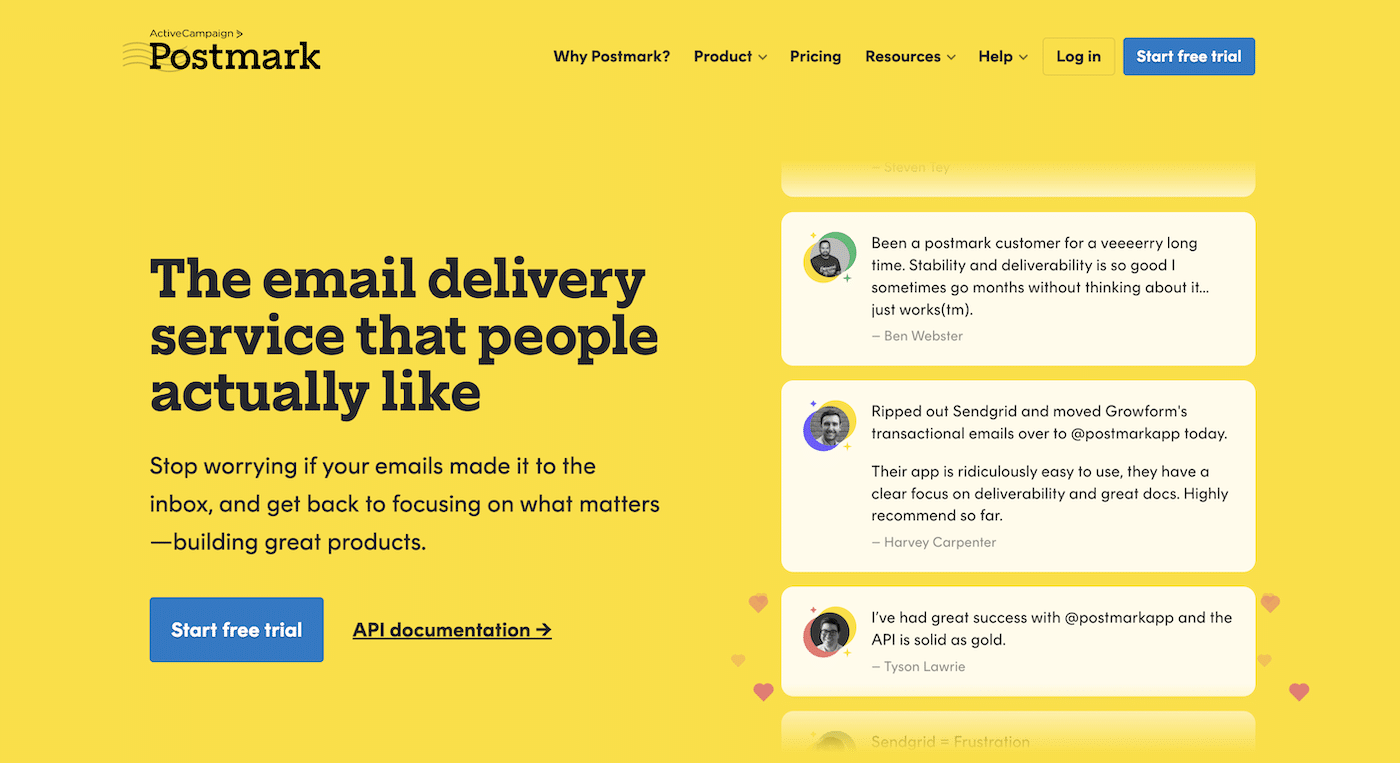
Postmark is a transactional email service that prides itself on its simplicity, speed, and excellent deliverability rates. Unlike some other providers that offer both marketing and transactional emails, Postmark focuses solely on transactional emails, allowing them to specialize and excel in this area.
One of Postmark’s standout features is its emphasis on speed. They guarantee that 99% of emails will be delivered to recipients’ inboxes within 10 seconds of being sent. This can be crucial for time-sensitive transactional emails like password resets or order confirmations.
Postmark also boasts impressive deliverability rates, consistently achieving over 99% inbox placement. They achieve this through a combination of dedicated IP addresses, rigorous sender screening, and proactive monitoring of delivery issues.
Postmark offers both SMTP and API integration options, with libraries available for various programming languages. They also provide a range of well-designed email templates that you can use as a starting point for your transactional emails.
Who This Service is Most Suitable For
Postmark is ideal for businesses that prioritize delivery speed and reliability for their transactional emails. It’s particularly well-suited for companies that send critical transactional emails where timely delivery is crucial. The service is also a good fit for developers who appreciate a clean, well-documented API.
My Experience
When I first started using Postmark, I was immediately impressed by the clean, intuitive interface. Setting up my first transactional email took just a few minutes, and the provided templates were a great starting point.
The delivery speed lived up to the hype. I sent a batch of test emails, and they arrived in my test inboxes almost instantly. This was a noticeable improvement over some other services I’ve used.
I particularly appreciated the detailed delivery insights. Being able to track each email’s journey from send to delivery to open was incredibly useful for optimizing my transactional emails.
Overall, while Postmark may not be the cheapest option, I found its focus on speed and reliability made it an excellent choice for critical transactional emails.
Pros and Cons
👍 Pros:
- Excellent delivery speeds and reliability
- High deliverability rates
- Detailed delivery insights and tracking
- Clean, developer-friendly API
- Responsive customer support for all plans
👎 Cons:
- Focused solely on transactional emails (not suitable if you also need marketing email capabilities)
- Can be more expensive than some competitors
- Fewer advanced features compared to some all-in-one email platforms
Pricing
- 10,000 emails – $15/month
- 50,000 emails – $55/month
- 125,000 emails – $115/month
- 1.5 million emails – $775/month
Postmark’s pricing starts at $15 per month for up to 10,000 emails. Beyond that, they offer volume-based pricing that becomes more cost-effective as you send more emails. They also offer a 100 emails/month free trial that doesn’t expire, allowing you to thoroughly test the service before committing.
Which Is the Best Transactional Email Service?
As we’ve seen, each of these transactional email providers has its own strengths and is suited to different types of businesses and use cases. Whether you’re a small startup just beginning to implement transactional emails, or a large enterprise sending millions of emails a day, there’s a provider out there that can meet your needs.
At SendLayer, we believe we offer an excellent balance of features, ease of use, and affordability that makes us a great choice for many businesses, especially those just starting out or looking for a user-friendly solution. However, we also recognize that the best choice depends on your specific needs and circumstances.
When choosing a transactional email provider, consider factors such as your email volume, technical requirements, budget, and the level of analytics and support you need. Don’t hesitate to take advantage of free trials and test out different services to find the one that works best for you.
That’s it! Now you know all about the best transactional email services
Next, would you like to learn why your standard email provider has deliverability issues? Check out our article on the most common reasons for poor email deliverability for more information.
